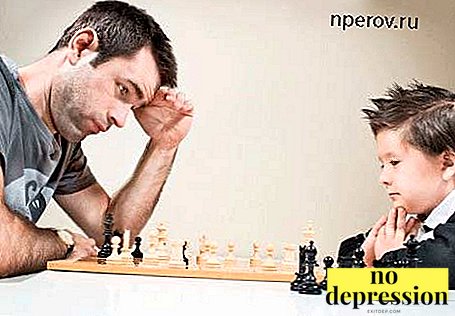Conflicts are an integral part of people's lives.
The ability to behave correctly in adverse circumstances is the key to calm and confidence.
For this reason, it is useful for any person to study examples of what could be conflict situations and how to resolve them.
The concept and psychology of conflictology

Conflict - what is it? In short, this clash of interests, opinions and views.
As a result of the conflict, a crisis situation arises in which each participant in the clash seeks to impose its own point of view on the other side.
Unresolved conflict can lead to open confrontationin which the subject of the dispute is relegated to the background and in the first place are the ambitions of the parties.
As a rule, as a result of the conflict, there are no losers and winners, since all participants spend their energy and as a result do not receive positive emotions.
Especially dangerous represent internal conflicts when a person is tormented by conflicting thoughts and desires that tear him apart. Protracted states of internal conflicts often end in depression and neurosis.
Modern man needs to be able to recognize the beginning of a conflict in time, to take competent steps to prevent the growth of the conflict and its elimination at the nascent stage.
If, however, the conflict cannot be immediately repaid, it is necessary to be able to build the correct line of conduct and correctly out of conflict with minimal losses.
How does it come about?

As a result of numerous studies, it was determined that most conflicts arise without the relevant intentions of their participants.
Often, people involuntarily react to conflict situations of other people, or they themselves are the source of conflict situations, as a result of which a stressful situation arises.
Conflict - words, actions, actions leading to conflict. They occur when there are any psychological problems among the participants, or are used purposefully to achieve the goals.
Most of the conflict genes manifest for the following reasons:
- thirst for excellence. The desire to prove their worth;
- aggressiveness. Initially aggressive behavior towards other people, caused by a negative emotional state;
- selfishness. The desire to achieve their goals at any cost.
How do conflicts arise? True causes and resolution methods:
Popular methods of resolving the situation
The most effective strategies that are used most often in practice to manage conflict:
- Avoid. One of the parties is eliminated from the dispute, showing a reluctance to continue the discussion.
- Change subject. The dispute is translated imperceptibly into another direction. For example, indirectly related to the main subject of the dispute. As a result, the conflict in the absence of the former emotional tension gradually fades away.
- Clash. Each party insists on its position, which leads to the need to resolve the situation by taking into account the opinions of both parties to the dispute.
- Device. One of the parties is trying to find ways to resolve the situation, which will make it possible to eliminate the subject of the dispute.
- Putting off. One of the parties takes a break to think about the situation.
- Reconciliation. Mutual recognition of the conflict has been exhausted. As a rule, this is possible only with the mediation of a third party.
- Compromise. Reaching a compromise solution as a result of the peace negotiations.

About ways to resolve conflicts in this video:
Resolution methods
From a scientific point of view, there are specific methods of conflict resolution:
Structural
Most often used in the professional field. These include:
- Clarification of requirements. The participants of the confrontation receive clear instructions on whose competence this or that issue lies. The possibility of a conflict is excluded due to the lack of common interests between which a collision may occur.
- Using special mechanisms management. A clear system of actions is developed and put into practice in the event of a negative situation that may turn into a conflict. The system makes it possible to determine in the early stages an incipient dispute and eliminate it before proceeding to the next stage.
- Setting goals. Bringing the parties together to achieve a common goal will require complete reconciliation and the elimination of any differences. The desire for such a union for the sake of a common goal is observed only with a high level of motivation.
That is, the goal should be of high importance for all parties to the conflict.
- Application of rewards. The absence of conflict, the ability to find a common language and reach compromises can be encouraged by a specially designed reward system.

Constructive
How to resist aggression and successfully resolve the conflict? Such methods of conflict resolution are used more in interpersonal communication.
For successful resolution of the situation with the help of constructive methods it is necessary to form an adequate perception of the situation among the participants, arrange them towards open interaction, create an atmosphere of goodwill and trust, jointly determine the root of the problem.
Design styles include:
- Exemption from negative emotions. You can break free from negative attitudes by using various relaxation techniques, briefly exiting the room, openly expressing your experiences, quietly listening to the opinions of third parties, etc.
- Build a dialogue. Calm interlocutors share their experiences. Everyone listens quietly to the position of the opponent and then retells in his own words what he heard. So a person is trying to objectively assess the position of the second side and look at the situation from a different angle.
- Demonstration of a positive attitude. It is necessary to show the second side that, despite the situation that has arisen, there is respect for the opinion of the other person and the acceptance of his point of view.
- Analysis of their behavior. One should frankly evaluate the motives of one’s own behavior, and adequately determine the degree of significance of one’s own position for oneself.
Often, such an analysis leads a person to the idea that the essence of the conflict is not so significant for him, and he can easily give up the dispute that has begun without suffering any losses.
- Joint resolution of the situation. The parties together decide on the end of the dispute (come to a compromise, find ways to solve the problem, etc.).

Integral
Allows each side to feel like a winner.. A similar effect is achieved if the parties agree to give up their initial positions, reconsider the situation and find a solution that satisfies everyone.
The method can only be used if the participants in the dispute demonstrate the flexibility of thinking and the ability to adapt to new circumstances.
Compromise

The most peaceful, mature way resolution of the situation.
The parties decide on mutual concessions in order to eliminate the negative factors that caused the dispute.
Such behavior of people allows not only to peacefully resolve the emerging contradictions. without prejudice to anyonebut also to build long-term communication links.
Out of conflict
How to get out of conflict situations? To get out of this unpleasant situation need to take the following steps:
- Stop using words or perform actions that provoke a negative feedback from your opponent.
- Do not respond to such behavior by the interlocutor.
- Demonstrate location with respect to another person. You can do this with gestures, facial expressions, words. Smiling, stroking on the shoulder, shaking hands, using polite phrases all contribute to smoothing disputes.
The interviewee immediately acquires a positive attitude and the situation is soon resolved.
Examples of conflict situations
In society

Social conflicts are best resolved using constructive methods.
For example, neighbors of an apartment building may come into conflict, caused by the distribution of parking spaces in the yard area.
Some neighbors will insist on the organization of a clear marking, in accordance with which each car is assigned a specific place for parking. Other tenants will advocate the possibility of free placement of cars.
In this situation the most effective methods of resolving a dispute will be building a dialogue, joint resolution of the situation with the help of a compromise.
It is enough for tenants to organize a meeting and decide on it that a part of the area in the yard is allocated for individual parking, while another part remains for supporters of arbitrary parking.
Between employees
Disputes in the field of management are best addressed by structural methods.
For example, employees of one team may come into conflict in connection with inability to work together in one direction.
Each defines for itself a range of responsibilities that is not approved by his colleague. The result is the emergence of a conflict situation and the ineffectiveness of teamwork.
The head of staff who entered into the dispute, you must apply the methods of clarifying requirements, setting goals and the appointment of remuneration.
Each employee will be explained the principle of his work, a clear range of duties. Before colleagues joint goals will be set, reaching which they will receive the promised remuneration (bonus, promotion, etc.).
How to resolve conflicts correctly? Find out from the video:
Completion Forms

What refers to the form of ending the conflict? The clash of interests can be completed as follows:
- Resolution. Prerequisites may be the parties' desire to stop the dispute and not return to it in the future. For the final resolution of the conflict may require the involvement of third parties. This is especially true in the field of professional relationships.
- Attenuation. The dispute may cease to be relevant for one of the parties, or for all participants in the process. In the first case, the second party does not find a response to their own words and actions and is forced to end the conflict. In the second case, the parties simultaneously decide not to continue the dispute due to fatigue, the end of arguments, the loss of interest in the subject of the dispute, etc.
This type of conflict termination is not always a positive result, because if a new stimulus arises, the dispute may resume with a new force.
- Settlement. The parties come to a compromise, reach mutual agreements. As a result, the dispute is resolved through constructive dialogue and effective interpersonal interaction.
- Elimination. The basis of the conflict is eliminated, transformed, modified, etc. In other words, the subject of the dispute ceases to be relevant at the current time and the fact of a conflict of interests disappears automatically.
- Growing into a new argument. Untold contradictions on one issue can be the source of new conflicts generated by the primary dispute. Especially often this effect is observed in the sphere of family relations, when a remark made by one spouse on a certain issue develops into a mutual exchange of reproaches.
Completion is not always permission

Does the end of a conflict always mean its resolution? It is important not to confuse the concept of the completion of a conflict situation with its resolution.
Ending conflict - this is the moment of the end of the parties' actions at the current time, the termination of the dispute for various reasons (attenuation, escalation into a new dispute, etc.)
Completion of the dispute currently does not guarantee that will not reappear after some time. This is due to the fact that the source of the conflict is not divided anywhere, and the parties have not achieved any result.
Conflict resolution involves the conscious application of methods and techniques aimed at correcting the negative situation that has arisen.
Resolved conflict allows the parties to reconcile and no longer return to the subject of dispute.
Thus, conflict can arise in any area of human life. as a result of the collision of his interests with the interests of other people.
There are many ways out of conflict. It is important to be able to apply them in practice before the situation has moved to a serious level.
How to communicate with other people, if you have different points of view with them on some issues, in this video:



